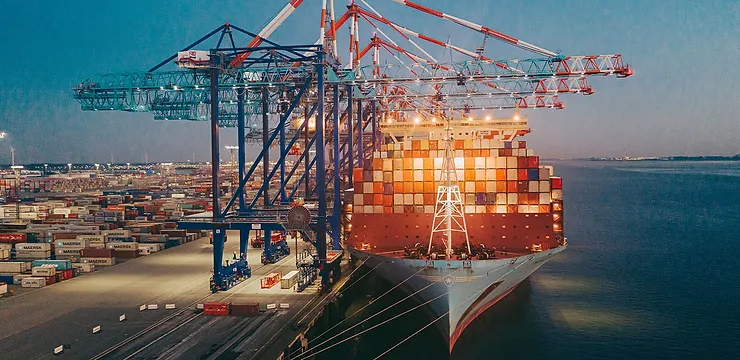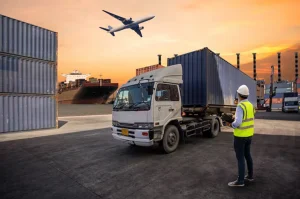Sea freight transportation plays a vital role in the global economy, and its importance cannot be overstated. Sea freight is the backbone of international trade, responsible for the movement of a significant portion of goods between countries. It allows for the exchange of products and commodities on a global scale, contributing to economic growth and development.
Every stage of sea freight transportation
Sea freight transportation involves the movement of goods in containers or bulk cargo by ships across oceans and seas. Here’s an overview of what happens during sea freight transportation from the origin to the destination:
-
Booking and Documentation: – The process begins when a shipper (exporter) or a freight forwarder books space on a cargo vessel with a shipping line. – Shippers are responsible for preparing and providing the necessary documentation, including the bill of lading, commercial invoice, packing list, and any required certificates (e.g., certificates of origin, inspection certificates).
-
Cargo Packaging and Preparation: – Goods are packed into containers or onto pallets, and proper packaging is essential to prevent damage during transit. – Hazardous goods must comply with international regulations and be appropriately labeled.
-
Customs Clearance: – Shippers or customs brokers handle customs clearance procedures, ensuring that the cargo complies with all export and import regulations of the origin and destination countries.
-
Cargo Handling at the Origin Port: – The cargo is delivered to the port of origin, where it undergoes inspections, security checks, and verification of documentation. – Containers are loaded onto the ship, and bulk cargo is loaded directly into the ship’s holds.
-
Voyage: – The cargo vessel departs from the origin port and sails across the ocean or sea to the destination. – During the voyage, the ship’s crew is responsible for maintaining the vessel and ensuring the safe transport of the cargo.
-
Port of Discharge: – The vessel arrives at the destination port, and the cargo undergoes unloading operations. – Containers are typically offloaded using cranes, while bulk cargo is discharged using specialized equipment or conveyor systems.
-
Customs Clearance at Destination: – Customs clearance procedures are conducted at the destination port, ensuring compliance with import regulations.
-
Inland Transportation: – After customs clearance, the cargo may be transported from the port to its final destination using trucks, trains, or other forms of inland transportation.
-
Distribution and Final Delivery: – The cargo is delivered to the consignee (importer) or their designated location. – In some cases, cargo may be transferred to a distribution center or warehouse before final delivery to retailers or end customers.
-
Return of Empty Containers: – Empty containers are typically returned to a container depot for inspection, maintenance, and reuse. Throughout this process, various parties, including shippers, consignees, freight forwarders, shipping lines, customs authorities, and transportation providers, play essential roles in ensuring the smooth and efficient movement of goods. Proper planning, documentation, and compliance with international regulations are critical to the success of sea freight transportation. Additionally, factors such as weather conditions, port congestion, and geopolitical events can impact the timeline and cost of the shipment.
Sea freight transportation: what should be taken into account?
When considering sea freight transportation for your goods, several important factors should be taken into account to ensure a successful and cost-effective shipment. These factors can impact the efficiency, safety, and overall success of your cargo’s journey.
-
Type of Cargo: – The nature of your cargo, whether it’s containerized, bulk, hazardous, perishable, or oversized, will affect the choice of shipping method and equipment.
-
Shipping Route: – Determine the most suitable shipping route, considering the distance, transit time, and potential stops at multiple ports. Some routes may be more direct but also more expensive.
-
Container Selection: – Choose the right type and size of container for your cargo, whether it’s a standard dry container, reefer container (for temperature-sensitive goods), flat rack, or open-top container.
-
Cargo Packaging: – Properly package and label your cargo to prevent damage during transit. Ensure compliance with international regulations for hazardous materials, if applicable.
-
Documentation: – Ensure all necessary documentation, including the bill of lading, commercial invoice, packing list, and certificates, is accurate and complete.
-
Customs Compliance: – Understand the customs regulations and requirements of both the origin and destination countries. Compliance with import/export regulations is crucial.
-
Insurance: – Consider purchasing cargo insurance to protect against potential loss or damage during transit.
-
Transit Time: – Assess the acceptable transit time for your cargo and choose a shipping service that aligns with your timeline.
-
Port Selection: – Select suitable ports of loading and discharge based on proximity to your location, infrastructure, and available shipping services.
-
Port Congestion and Delays: – Be aware of potential port congestion issues, labor strikes, or other delays that could affect the arrival and departure of your cargo.
-
Freight Rates and Costs: – Obtain competitive freight quotes from different shipping lines and freight forwarders. Consider all associated costs, such as handling fees, customs duties, and inland transportation.
-
Regulatory Compliance: – Stay informed about international trade regulations, sanctions, and trade restrictions that may affect your cargo or the countries involved.
-
Security: – Implement security measures to protect against theft, tampering, and piracy during transit.
-
Weather and Seasonal Considerations: – Consider the impact of weather conditions, such as storms or typhoons, on your shipment, especially if your cargo is time-sensitive.
-
Contingency Planning: – Develop contingency plans for unexpected events or disruptions that could affect your cargo’s transportation. By carefully considering these factors and working with experienced logistics partners, you can navigate the complexities of sea freight transportation and optimize your supply chain for efficiency and reliability.
TopTrans: Your Sea Freight Partner 🌊
At TopTrans, we understand that sea freight transportation can be a complex and challenging journey. That’s why we’re here to offer you a helping hand and make the entire process seamless and stress-free. Here’s how TopTrans can assist you during sea freight transportation:
Expertise in International Logistics
Our 7 years of industry expertise in international cargo transportation, including sea freight, make us your trusted partner. We have a deep understanding of the intricacies and nuances of global logistics, ensuring your cargo is in capable hands.
Comprehensive Range of Services
TopTrans provides a comprehensive range of services to meet all your sea freight needs. Whether you’re shipping general cargo, hazardous materials, or military shipments, we have the experience and resources to handle it all.
Cost-Effective Solutions
We offer competitive prices without compromising on the quality of service. Our cost-effective solutions ensure that your sea freight transportation remains budget-friendly while maintaining the highest standards of safety and efficiency.
Safe and Trouble-Free Delivery
Your cargo’s safety is our top priority. We employ stringent safety measures, from proper packing and containerization to secure loading and stowage, ensuring your cargo arrives at its destination in pristine condition.
Global Reach
With our well-established transport lines covering Georgia, including Tbilisi, Batumi, and Poti, as well as various international directions, including European Union countries, Turkey, Central Asian States, Ukraine, and China, we offer global reach for your cargo transportation needs.
Customized Solutions
No two shipments are alike, and we understand that. TopTrans offers personalized and customized solutions to cater to your unique cargo requirements. We’ll work closely with you to determine the ideal container size, shipping route, and additional services needed.
Real-Time Tracking
Stay informed about your cargo’s journey with our robust tracking system. You can monitor your shipment’s progress in real-time, giving you peace of mind throughout the voyage.
Handling Specialized Cargo
TopTrans has the experience and capabilities to handle specialized cargo requirements. If you have unique cargo needs, trust us to find the right solutions to meet your specifications.
Timely Support
Our customer service team is always ready to assist you. Whether you need a quick quote, have questions about your shipment, or encounter any challenges along the way, we’re just a message or call away.
Contact us today for a quote or any inquiries, and experience the difference of working with a reliable and experienced sea freight partner. Your cargo is in good hands with TopTrans. 🚢🌏








